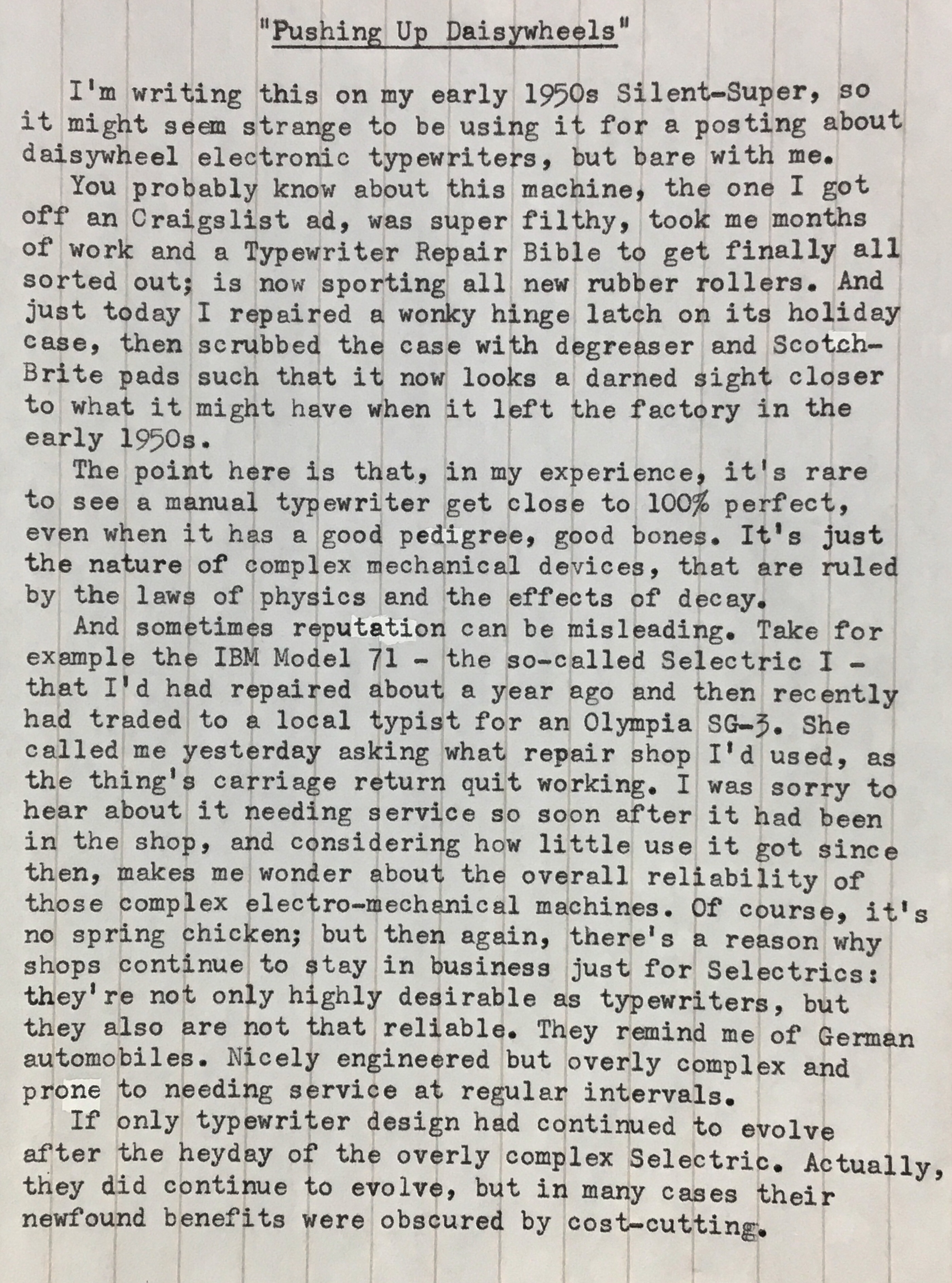Pushing Up Daisywheels




Post-Script: There's no getting around the fact that most of us typewriter aficionados are in it mainly for the aesthetics and build quality over just the pure writing experience. Meanwhile, most non-aficionado people I've talked to during public typewriter gatherings couldn't care less about shiny black pre-WWII manual machines, for instance; they just wanted and needed a machine to reliably produce copy to keep the boss happy; a practical, reliable writing tool. In that regard these well-made Nakajima daisywheel machines fit the bill perfectly.
Sure, they sport an ungainly footprint; I have no need to type crosswise on legal-sized paper, thank you very much. Likewise, I'm not enamored by beige plastic everywhere I look. But I've got to say, when it comes to throwing down letters on paper reliably, these machines just do the job.
Because of their design, you just aren't going to have those nagging little issues that plague even the best of manual typers, regardless of how we might love their build quality and appearance. Electronic typewriters seem to function in a Boolean fashion: they either work, or they don't. There's little middle ground of so-so action, like with manual machines.
Daisywheel machines aren't without their disadvantages, let no one convince you otherwise. Their ungainly footprint is due to the fact that the print mechanism requires a wider throw than the width of the platen itself, to accommodate the drive band, pulleys and width of the print mechanism. They are also invariably chained to a power cord, there's little getting around that. In comparison, our beloved little thermal machines begin to appear a lot closer to ideal, were it not for that one sticky problem of needing to use thermal paper. Daisywheel machines are boringly efficient. If you need writing done, they'll do it in spades, but won't scratch your aesthetic itch like our lovely manual typewriters.
What I've tried to convey in this post is that there are intrinsic tradeoffs. While it would be nice to have every manual machine in our collection operate absolutely, 100% flawlessly all the time (and I am seeing a new trend toward quality over quantity with typewriter collectors), that just ain't going to happen, for a number of reasons, mainly to do with physics and the Second Law of Thermodynamics. So our expectations need to be adjusted to the reality of owning, and using, these marvelous mechanical writing instruments.
Likewise, these nearly flawless Nakajima machines have their aesthetic downsides that just aren't going to be resolved. We have to learn to live with them, if we are to use them for their intended purpose, which I think to be serious writing.
Will a daisywheel machine offer the same advantages over word processing on computers as we experience with manual machines, that of reduced distraction and enhanced focus? Absolutely. And they'll most likely do so with less fuss and bother since, in spite of their plastic bodies and electronics, they represent an intrinsically more reliable design. But you won't be going to the cabin or the woods with one, and you'd be hard pressed to use one after The Big One hits and the power grid is down and you've ran out of carbon film cartridges. But in the meanwhile, before it does hit, if you have some serious writing to do, consider one of these machines as the epitome of typewriter evolution.
PPS: No, I'm not giving up my manual machines anytime soon. But this is the second Nakajima daisywheel in my collection, and I remain impressed. Also, they're still being made today, and marketed in the US under the Swintec name.
Yes, I need a new correction tape in the Sears Nakajima, thank you for noticing!
PPS: Yes, I had issues with Flickr inverting my images, I hope it's all fine now.

4 Comments:
Nice work on the Daisywheel.
Everytime I see or hear of anyone cleaning an old plastic machine I wish I still had a can of the great plastic cleaner/polish I had when I worked at Dictaphone in the 70s. It was like Bon_Am-I with pumice in it and cleaned old yellowed plastic to make it white (or beige) again and shine like chrome just polished with the finest chrome polish.
I doub't I'll eve add any daisywheel or electrics to my collection though. They just do not have the longevity of a manual typewriter, and they all need tethered life support from the electric company.
Maybe you can find a 1/2 full container of Glass-Wax. I think they had a slight abrasive compound.
It's a reasonably attractive writing machine IMO. The smaller AX-240 and AX-255 "ALL" Nakajimas (also sold as "Sears") have similar keytops, a smoked glass effect plastic lid/paper rest and a stylish Baby Selectric-like platen knob. The early Adler-Royals were quite stylish too. ;)
Oh, also note that the correction tape they use is identical to the tape for Selectrics (II and III), and nearly every other daisywheel that has a correction tape on an orange reel rather than a cartridge. Easy to find and cheap. :D
Post a Comment
<< Home